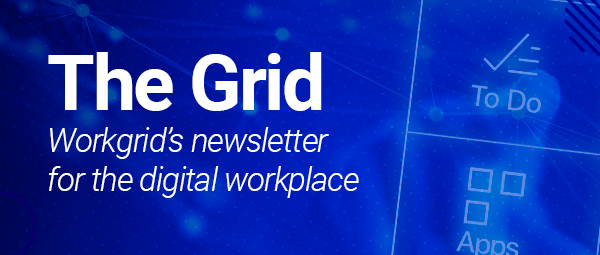Problems of the modern working age
Let’s be honest. No matter how much we like our jobs, we’d all rather be independently wealthy than go to work every day. Of course we would. Work is defined as “activity involving mental or physical effort” and “something a person or thing has to do.” Nobody wants that.
Setting aside the beautiful fantasy that we all just wake up with fat, bottomless bank accounts and can spend our days doing whatever we please, there are some real reasons why work is more challenging and draining than it needs to be. The biggest is that the average workday is filled with waste.
Employees spend one third of their lives working and much of that time is spent churning on a wheel of misused time, attention blackholes, and digital friction. Productivity drops by up to 40% as employees waste a sizeable chunk of their day context switching, app hoping, and even worse, searching and reviewing the wrong information.
![[asset] Digital-Friction-Cartoon](https://images.ctfassets.net/z7p73u8c0thn/71xiv8svWPSHho7Y6HwwqT/8618a111e66c4dc63a0e70b91e3668c1/woman-g5a6827a6a_1280.png?w=1200&h=743&q=60&fm=png&bg=transparent)
Workers spend 2.5 hours daily searching for information needed to do their jobs – which in a workforce of 1,000 translates to 655,000 work hours wasted every year.
This isn’t just supposition or hyperbole, it’s a fact. Check out these statistics:
68% of workers toggle between apps up to 10 times an hour
31% of workers said toggling causes them to lose their train of thought
53% of workers find navigating between apps more annoying than doing household chores
41% of all information provided to employees is irrelevant to their specific job role
Some studies suggest it takes it takes a full 23 minutes to recover your focus after distraction
Wasn’t technology supposed to improve our lives?
This war on attention and the growing prevalence of digital friction is a big problem that organizations need to solve now if they’re going to successfully navigate the future of work. So, let’s talk about it – what is digital friction, where does it come from, and how can we get in front of it?
Digital friction - what is it and where does it come from?
Gartner® describes digital friction as “the unnecessary effort an employee has to exert to use data or technology for work. This gets in the way of focusing on the right tasks and making the right decisions.” Basically, it’s all the digital “stuff” that creates roadblocks. Extra steps. Duplicative systems. Hard to find data and information. All the time wasters that prevent employees from focusing on high-value work.
But where does digital friction come from? It’s all around us and it falls into three main areas:
Application overload – the ever-expanding range of applications and sources where information and activity are hosted.
Information overload – the volume of content, conversations, activity, interactions, tasks, and information employees are expected to continually process.
Digital noise pollution – the exponential echo effect of signals, pings, and chimes vying for employees’ attention.
Let’s take a look at each of these sources a little more closely…
Application overload
![[asset] digital friction app overload](https://images.ctfassets.net/z7p73u8c0thn/2wDbjak97uW2ui2s9p6mK/ad729fc2fb001fdb3a9450c27eedabca/digital_friction_app_overload.jpg?w=780&h=400&fl=progressive&q=60&fm=jpg&bg=transparent)
“…the average Global 2000 employee uses 35 different tools a day, switching back and forth more than 1,100 times” (Source)
App sprawl isn’t new. For as long as there have been applications, there has been a drive to create more and better ones, with new apps springing up all over the place to meet every imaginable need. But we’ve gone beyond simple sprawl into application overload territory. Redundant, unrationalized technology that’s deployed with little to no guidance on what to use when. There are simply too many apps for workers to reasonably manage. It’s an issue that has only gotten worse during the pandemic as organizations scrambled to implement technology that addresses the unique and changing needs of a hybrid and remote workforce.
In fairness, all of these applications have been deployed with the best of intentions. They all promise to enhance productivity, increase collaboration, accelerate user adoption, and, of course, deliver tons of ROI. When viewed independently, it seems like a no-brainer to add them all to the tech stack. Unfortunately, these apps don’t work in a vacuum. They’re just a small part of the overall suite of digital solutions and services the average employee interacts with. So, when taken as a whole, this proliferation of apps creates significant confusion for end users – especially when not governed properly from a strategic lens.
Just think about your own experience trying to collaborate and forage for information. Should you look for it in a wiki or maybe a Slack channel? Maybe you should set up a Teams or Slack call? Should the document be in SharePoint or OneDrive? The options are endless, and the result is always frustration and confusion.
The bottom line is this: The more areas there are to perform activities and find information, the more likely digital friction increases.
Information overload
There’s a term that floated around for a bit back in the early 2010s – “Infobesity.” It referred to the collection of too many sources and streams of content, information, artifacts, and resources that compromised an organization’s ability to execute and make decisions rapidly. Today, we recognize that this concept is integral to the bigger issue of digital friction.
Digital friction isn’t just created by confusion about where to go to find information. It’s also produced by the sheer volume of information that’s generated by an organization – information employees must painstakingly sift through to do their jobs.
The more applications peppered into an organization’s tech stack, the more silos of data and information are created that stand in the way of workers being productive and efficient. It also proliferates redundant capabilities, creating duplicative locations for where activities can be performed, and information can be stored. This waters down information saturation and activity richness, increasing the time it takes for users to discover, evaluate, and collaborate. The end result? The likelihood of outdated, overlapping information, which further creates slowdowns in productivity and decision making.
![[asset] Digital-Workplace-Digital-Friction Stock Photo1920x1080](https://images.ctfassets.net/z7p73u8c0thn/3eCiTAZMJMtnqgiqOGHsI2/98dc32dbb815d52a48f79cfa0e41b606/Digital-Workplace-Trends-Stock_Photos_1920x1080.png?w=1200&h=675&q=60&fm=png&bg=transparent)
Digital noise pollution
So, what’s the result of all these apps and the deluge of information they deliver?
Unfortunately, it’s digital noise pollution. Being constantly peppered with “noise” – all the pings, alerts, signals, emails, @mentions, tasks, and to-dos – none of which are prioritized – that constantly clamor for our attention. It’s exhausting. It’s also incredibly problematic for both businesses and their employees.
Human beings have finite attention spans as well as a limited capacity to retain and process data. Think about your own experiences. When an uncontrollable flood of information and signals is coming at you, what generally happens? In all likelihood, your stress increases as your brain struggles to process it all. Consequently, it becomes difficult to make good decisions (or even make any decision), and overall performance suffers.
This is the issue that employees struggle with all day, every day. It’s generally considered an employee problem, with the onus put on workers to figure out, which they admirably attempt to do by multitasking.
On paper, the multitasking approach makes sense. Humans are accomplished adapters, so training ourselves to simply become more mentally nimble in order to effectively navigate the fast-moving digital world should be a no-brainer. Except for one little problem – multitasking is a myth. A grand illusion that perpetuates the belief that with enough focus and practice, we can effectively juggle the multitudes of tasks and information that are being thrown at us.
Multitasking can’t be done, that’s a scientific fact. You might think that you’re handing a series of disparate tasks concurrently, but what you’re really doing is quickly switching between them.
![[asset] Myth-of-Multitasking](https://images.ctfassets.net/z7p73u8c0thn/1OiUJ4zwGvRW4RHABSscLl/9b03c967f81351fcb43a5933a2396804/Multitasking.JPG?w=678&h=637&fl=progressive&q=60&fm=jpg&bg=transparent)
“The Myth of Multitasking: Why Fewer Priorities Leads to Better Work”
So, what’s really needed, then, to solve the problem of digital friction?
Organizations need to take responsibility for helping employees work effectively – and that starts by optimizing their attention. Here’s how it’s done…
Overcoming digital friction
These days, minimizing workplace distractions is the fastest way to help employees overcome stress and burnout, and optimize their potential. The more you can streamline platforms by simplifying logins, access, transactions, and communications, the better it is for everyone.
In order to know where streamlining is most needed, you should start by understanding the culture and personas across the organization, as well as the process and technology landscape they face each day. With a deep understanding of that, you can then move on to …
Addressing quick wins — taking steps to alleviate employees’ top pain points.
Modernizing legacy systems — assessing how existing technology could be perpetuating ongoing problems and asking foundational questions such as:
When was the last time the digital landscape was rationalized?
What's being used?
What's not being managed?
When should certain technologies be used and for what activities?
How much tech debt has accrued over the recent years?
Utilizing outcome-driven design — designing processes that help employees fulfill their intent and achieve their desired outcome as effectively as possible by asking questions about how employees wish to communicate, collaborate, connect, and operate.
Facilitating multichannel delivery— delivering experiences wherever employee needs access, whether that’s via mobile, in a workstream collaboration app like MS Teams, or even on the intranet.
It’s ironic that in a time of such tremendous change, something as foundational as simplifying the digital workplace would be the key to progress. But it’s like the great Steve Jobs once said, “Simple can be harder than complex. You have to work hard to get your thinking clean to make it simple. But it’s worth it in the end because once you get there, you can move mountains.”




